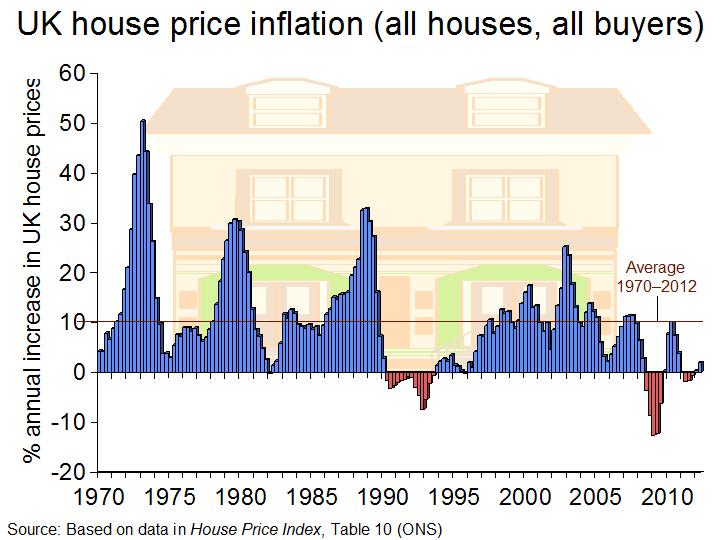 The housing market is crucial in any economy, as it provides so many jobs in related industries. It is frequently a good signal of how buoyant the economy is. With recession in the UK, mortgage rationing continuing and many homeowners having to find 20% deposits to buy a house, many would expect the housing market to be showing signs of trouble.
The housing market is crucial in any economy, as it provides so many jobs in related industries. It is frequently a good signal of how buoyant the economy is. With recession in the UK, mortgage rationing continuing and many homeowners having to find 20% deposits to buy a house, many would expect the housing market to be showing signs of trouble.
And to some extent this is the case. Studies on house prices have clearly shown how unpredictable this market is and prices remain 0.7% below what they were a year ago. However, in August house prices increased, recording their biggest rise in two and a half years, at 1.3%. For many, this rise was a surprise, but came as a welcome relief following the declines in previous months. Despite this rise, analysts have suggested that this trend is unlikely to continue throughout the rest of the year, as the demand for houses remains weak. Robert Gardner, the Chief Economist at Nationwide said:
“Given the difficult economic backdrop, the extent of the rebound in August is a little surprising. However, we should never read too much into one month’s data, especially since monthly price changes have been impacted by a number of one-off factors this year, such as the ending of the stamp duty holiday for first time buyers’.
 So, what is behind this upward trend? Nationwide’s Chief Economist says that it could be explained by a resilient labour market, where employment has risen in recent months, despite the recession. The labour market undoubtedly has a big effect on the housing market, as mortgages do take up so a large percentage of take-home pay.
So, what is behind this upward trend? Nationwide’s Chief Economist says that it could be explained by a resilient labour market, where employment has risen in recent months, despite the recession. The labour market undoubtedly has a big effect on the housing market, as mortgages do take up so a large percentage of take-home pay.
However, another key factor that affects house prices is the availability of mortgages. The Bank of England and Treasury launched the Funding for Lending Scheme at the beginning of August in a bid to make mortgages cheaper and more easily available. However, analysts suggest that the scheme is yet to have an effect. Furthermore, until deposit requirements are eased, that first step on the property ladder will remain elusive for many people. Mortgage approvals did increase slightly in July, but still remain a major barrier for the housing market to really boom.
The following articles consider this ‘surprising’ rise in house prices and the factors behind it.
Articles
House prices in ‘surprising’ jump, Nationwide says BBC News (31/8/12)
UK house prices record surprise increase Financial Times, Tanya Powley (31/8/12)
Surprise house price rise in August not indicative of market, says Nationwide The Telegraph, Emma Wall (31/8/12)
House prices in surprise rebound Independent, Vicky Shaw (31/8/12)
House prices continue to hold The Economic Voice, Jeff Taylor (31/8/12)
Mortgage approvals still subdued, Bank of England says BBC News (30/8/12)
Banks are pulling back from property – expect prices to fall Money Week, Matthew Partridge (31/8/12)
UK house prices up, as London continues surge Share Cast, Michael Miller (29/8/12)
Data
Lending to Individuals Bank of England 2012
House Price Index Land Registry 2012
UK house prices (links) Economics Network
Questions
- Use a supply and demand diagram to analyse recent trends in the housing market.
- Why is the Bank of England’s lending scheme not having the expected impact on the housing market?
- To what extent do you think the state of the housing market depends on mortgage rationing? Which other factors are likely to affect the housing market?
- In the article from the Economic Voice, the author says that house prices holding as they are is a surprise, because of relatively high inflation and the fact that wages are not keeping pace. Explain the economic thinking behind this view.
- The Chief Economist at Nationwide has said that the future of the housing market depends heavily on what happens to the labour market. Why is this the case?
- Why have mortgages been rationed and minimum deposit requirements been increased?
- Why is the housing market so important for the economy?
 Weather has already been partly blamed for poor economic growth, in particular in December 2010 and January 2011. April 2012 is no different – the wettest April on record is said to have caused the worst performance in sales since March 2011.
Weather has already been partly blamed for poor economic growth, in particular in December 2010 and January 2011. April 2012 is no different – the wettest April on record is said to have caused the worst performance in sales since March 2011.
Like-for-like sales fell by 3.3%, mainly through lower demand for clothes and shoes. Supermarkets saw an increased demand for warmer food items with the colder weather and demand for home products also increased, with analysts suggesting that people decided to re-decorate their houses rather than venture outside! This was further supported by sales of gardening equipment, which also fell. However, the weather is not always bad – in March, sales were higher than expected, with the unusually warm weather, but unfortunately for growth statistics, the boost in sales in March has been more than offset by the decline in sales in April. Furthermore, there are concerns that the March ‘heat-wave’ may have encouraged consumers to do their summer shopping already and hence summer sales may suffer.
The retail data for April 2012 must be considered carefully, as comparing this month’s sales with the same period last year will be very misleading. Last April, the UK was hit with the Royal Wedding, which did boost sales of many products – underlying sales growth was recorded at 5.2% for the month. However, whilst April sales for 2012 could hardly hope to compete with April sales for 2011, the downward trend is undoubtedly going to cause concern for the government. Helen Dickinson, Head of Retail at KPMG said:
“While May will certainly be brighter than April, the health of the retail sector continues on a downward trajectory.”
Whether or not sales do continue their downward trend depends on many factors, including government policy measures to boost growth and cut unemployment. However, one other variable that may influence the trend is the weather. Here’s hoping that the sun shines and people begin to spend!
Weaker retail sales, job surveys raise risk of longer slump Reuters, Olesya Dmitracova (9/5/12)
Wettest April ‘hits retail sales’ BBC News (9/5/12)
Retail sales slide in wettest April on record Telegraph (9/5/12)
April showers wash out retail sales Financial Times, Sarah O’Connor (9/5/12)
Retail sales slip back 1 per cent as fashion stores weather April showers Independent, James Thompson (9/5/12)
Questions
- Use a demand and supply diagram to illustrate the effects of the weather on equilibrium price and output.
- What other factors besides the weather affect retail sales?
- What government policy measures could be implemented to try to boost the retail sector?
- From the information you are told are there any sectors that surprise you in terms of whether sales have risen or fallen? Explain your answer in each case.
- With sales in April falling, what is the implication for a firm’s profits? What steps might a firm take in a bid to boost sales?
 Oligopoly: it’s a complex market structure and although closer to the monopoly end of the ‘Market Structure Spectrum’, it can still be a highly competitive market. The characteristics are well-documented and key to the degree of competition within any oligopoly is the number of competitors and extent to which there are barriers to entry.
Oligopoly: it’s a complex market structure and although closer to the monopoly end of the ‘Market Structure Spectrum’, it can still be a highly competitive market. The characteristics are well-documented and key to the degree of competition within any oligopoly is the number of competitors and extent to which there are barriers to entry.
The greater the barriers and the fewer the competitors the greater the power the established firms have. This can then spell trouble for pricing and hence for consumers. The following articles are just some examples of the oligopolies that exist around the world and some of the benefits and problems that accompany them.
Articles
Oligopoly of PSU oil cos reason for high ATF prices The Indian Express, Smita Aggarwal (30/4/12)
Group energy buying hits the UK headlines Spend Matters UK/Europe(18/1/11)
German cartel office probes petrol companies on pricing Fox Business (4/4/12)
Gov’t unveils steps to lower fuel prices Yonhap News (19/4/12)
How big banks threaten our economy Wall Street Journal, Warren Stephens (29/4/12)
UK Governance: Call for Whitehall to simplify the landscape for SME suppliers to win more government contracts The Information Daily (26/4/12)
Other blogs
Pumping up the price: fuel cartels in Germany April 2012
Energy profit margins up by over 700% October 2011
Every basket helps October 2011
The art of oligopoly December 2010
Questions
- What are the assumptions of an oligopolistic market structure?
- Consider (a) the energy sector and (b) the banking sector. To what extent does each market conform with the assumptions of an oligopoly?
- In the ‘Spend Matters’ article, a group of people in a Lincolnshire village formed a local buying consortium to negotiate deals for heating oil. What could we refer to this as?
- To what extent is an oligopoly in the public interest?
- Explain how barriers to entry in oligopolies affect the competitiveness and efficiency of a market.
- Illustrate how an oligopolistic market structure can fix prices and hence exploit consumers.
- How have the actions of the big oil companies in both the UK and Germany been against independent retailers and the consumer interest?
- What action can governments take to break up oligopolies? Will it always be effective?
 46p – that buys you a First Class stamp. However, the price will now rise to 60p and the price of a Second Class stamp will increase to 50p from 36p, as Ofcom lifts some price caps. These significant price rises have seen shortages of stamps emerging across the country. As people anticipate the price rise, individuals and businesses are buying up stamps while they remain relatively cheap.
46p – that buys you a First Class stamp. However, the price will now rise to 60p and the price of a Second Class stamp will increase to 50p from 36p, as Ofcom lifts some price caps. These significant price rises have seen shortages of stamps emerging across the country. As people anticipate the price rise, individuals and businesses are buying up stamps while they remain relatively cheap.
The problem is that this has started to result in a stamp shortage, so much so that the Royal Mail has now begun rationing retailers’ supply of stamps, capping each retailers’ supply this month to 20% of its annual allocation. A Royal Mail spokesman said:
“We are more than happy for retailers to receive the normal commercial return they obtain on stamps and no more than that … That is why we have put in place a prudent allocation policy to safeguard Royal Mail’s revenues and ensure there are more than enough stamps for people to buy both now and in the future.”
With postage volumes falling, as individuals turn to other methods of communication, Royal Mail says that this price rise is essential to keep this universal service going. Revenues have been low and the Royal Mail has been loss-making for some time.
However, while the price rise may help the Royal Mail, many businesses may suffer in its place. One optician, who sends out approximately 5,000 reminders to patients each year intends to bulk-buy 10,000 stamps in the hopes of saving some £1,400 when prices of stamps rise. An IT worker bought 20 books of 12 first-class stamps and said ‘If I could afford it, I would buy a lot more’. Many are unhappy at the ‘shameless profiteering at the public’s expense’, but whatever your opinion about the price rise, it does make for an interesting case of demand and supply. The following articles consider this stamp shortage.
Man’s 10,000 stamp panic: stampede for stamps leaves a 1st class mess as Royal Mail introduces rationing ahead of 30% price rise Mail Online, Colin Fernandez and John Stevens (15/4/12)
Stamps rationed by Royal Mail in run up to price rise (including video) BBC News (13/4/12)
Stamp rationing could hit pensioners Telegraph, James Hall (14/3/12)
Stamp sales limited ahead of price hike Sky News (13/4/12)
How stamp collecting came unstuck Guardian, Hunter Davies (13/4/12)
Royal Mail limits supply of stamps ahead of price rise Telegraph, James Hall and Andrew Hough (12/4/12)
’Profiteering’ Royal Mail limits supply of stamps before price rise Guardian, David Batty (13/4/12)
Royal Mail’s stamp price rises come into force BBC News (30/4/12)
How businesses will be affected by Royal Mail’s changing prices BBC News, Catherine Burns (28/4/12)
Questions
- If people expect prices to rise, what will happen to the demand curve? Illustrate this idea on a demand and supply diagram?
- If suppliers anticipate a price rise, what would their best strategy be?
- On a demand and supply diagram, illustrate the shortage of stamps that has emerged. If left to the free market, what should happen to the price of stamps?
- Why could pensioners and those in rural areas be the most adversely affected by this shortage and price rise?
- Why could ‘children and new collectors’ be priced out of the market?
- Why will small businesses be affected by this price hike? How could their customers be affected?
 One problem for motorists at the moment is the cost of petrol, where prices have reached over 1.37p on average, as we considered in the blog It’s fuelling anger. However, another problem could soon materialise and that is no petrol. Back in 2000, there was massive disruption to the public with a fuel blockade and a similar thing could occur, following the ‘yes’ vote by fuel tank drivers in favour of strike action.
One problem for motorists at the moment is the cost of petrol, where prices have reached over 1.37p on average, as we considered in the blog It’s fuelling anger. However, another problem could soon materialise and that is no petrol. Back in 2000, there was massive disruption to the public with a fuel blockade and a similar thing could occur, following the ‘yes’ vote by fuel tank drivers in favour of strike action.
Over the past few years, strikes have occurred across a variety of industries and if this one did happen with no contingency plan in place, disruption would be significant to both private individuals and companies. Drivers from Unite (the trade union) supply over 90% of fuel to UK garages and so any strike could lead to the closure of up to 7,900 stations.
However, the government has begun to consider the worst case scenario, if talks do not work with plans to begin training army drivers. There are concerns that without these plans in place, disruption across the country may occur with supermarkets, garages and airports all facing fuel shortages. Those who have a job that relies on travel, or even those who simply use their cars or buses to get to work will also feel the effects. Other problems within the emergency services could also emerge, but the government has assured the public that their fuel would be prioritised. The following articles consider this issue.
Fuel strike drivers vote yes in row over conditions BBC News (26/3/12)
Plan for fuel strike, says Downing Street Financial Times, George Parker (27/3/12)
Talks urged to avert fuel tanker strike Independent, Andrew Woodcock and David Mercer (27/3/12)
Ed Miliband: Fuel strike must be avoided at all costs Telegraph, James Hall (27/3/12)
All striking tanker drivers want is responsible minimum standards Guardian, Len McCluskey (27/3/12)
Questions
- If a trade union bargains for higher wages, what is the likely effect on employment and unemployment?
- How might strike action by tankers affect businesses?
- Are there likely to be any adverse long term effects if strike action does occur over Easter?
- How could strike action affect a firm’s costs of production? Think in particular about those who rely on travel as part of the business.
- What other options are there to trade unions, besides striking? Assess the effectiveness of each of the options.
- If a shortage of petrol emerged, what would you expect to happen to its market price?
 The housing market is crucial in any economy, as it provides so many jobs in related industries. It is frequently a good signal of how buoyant the economy is. With recession in the UK, mortgage rationing continuing and many homeowners having to find 20% deposits to buy a house, many would expect the housing market to be showing signs of trouble.
The housing market is crucial in any economy, as it provides so many jobs in related industries. It is frequently a good signal of how buoyant the economy is. With recession in the UK, mortgage rationing continuing and many homeowners having to find 20% deposits to buy a house, many would expect the housing market to be showing signs of trouble. So, what is behind this upward trend? Nationwide’s Chief Economist says that it could be explained by a resilient labour market, where employment has risen in recent months, despite the recession. The labour market undoubtedly has a big effect on the housing market, as mortgages do take up so a large percentage of take-home pay.
So, what is behind this upward trend? Nationwide’s Chief Economist says that it could be explained by a resilient labour market, where employment has risen in recent months, despite the recession. The labour market undoubtedly has a big effect on the housing market, as mortgages do take up so a large percentage of take-home pay.


